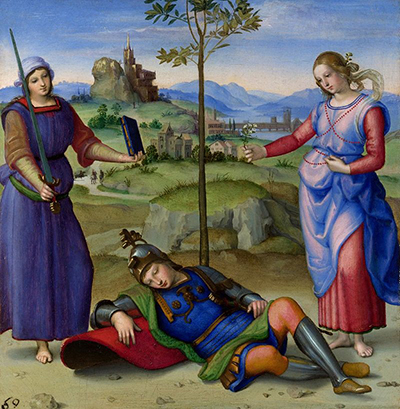The Vision of a Knight, which is also known as Allegory or The Dream of Scipio is an egg tempera painting on the poplar by Raphael who was an Italian Renaissance artist.
The artistic work was finished in the years 1504 to 1505. The vision of a Knight is currently found in the London National Gallery. The painting formed an excellent pair with the three Graces panel found in the Chateau de Chantilly museum. Currently, various theories are explaining what the panel was intended to represent. Most art historians and researchers think this painting represents Scipio Africanus, the Roman general who dreamed that he had to select between pleasure and virtue. However, the two main figures aren’t presented as contestants. It may represent or express the idea attributes of the knight including the flower, sword and the book which they are holding.
His early career coincided with the use of oil paints in Italy. He used egg tempera in many of his paintings, and the mixture was common with other artists of his generation. By the time he decided to settle in Rome, all of the paintings were executed in oil. Raphael used both the paper and vellum to achieve The Vision of a Knight painting. Most of the artistic work consists of pieces of paper glued together. The medium that was used in this painting was a certain type of gouache made up of a pigment bound in animal glue. Most of his artistic works show that he experimented with an oil medium to achieve his richer colour and the excellent depth of the shadow.
While on his mission, he was influenced stylistically by various local artists he befriended. The most famous and notable was Bartommeo from whom he learnt to replace a fragile grace of his master, Perugino with the more measured movement, gravity, and grandeur. He also adapted various inventions in painting that most historians would have recognized as Leonardo’s. Raphael’s painting style changed in Florence, where most of his work was experimented with ink and pen. They were often used as rougher means of exploring and generating ideas and defining them. Raphael’s Sketches and drawings, perhaps executed from memory include artistic works by Michelangelo, Donatello and Leonardo.
The painting clearly shows a gentleman sleeping under a beautiful tree flanked by two ladies. One is holding a sword and a book while the other is holding a flower. The small photo is an allegorical painting. It is believed that the gentleman is representing Scipio Africanus, the Roman hero who is in a dream with two choices between the virtue and pleasure. Also, the most likely origin for the allegory represented by the painting is from a certain passage in the Punica and an epic artistic poem that recounts the Punic War by the famous Latin poet Silius. The painting was moved to England by Young Ottley in the year 1800. Raphael, who was the artist, used the extensive palette of paints to express this beautiful scene. Pigments like verdigris, ultramarine and lead-tin yellow have been identified in his work.




